Smart Electric Vehicle Charging in the Era of Internet of Vehicles, Emerging Trends, and Open Issues
Abstract
1. Introduction
- We have discussed an overview of IoV to provide the next step of EV research.
- We have envisioned the Internet of Vehicles (IoV) in a broader context, where people, fleets of electric vehicles, utilities, power grids (centralized generation, distributed renewable energy generation, distributed storage), peer-to-peer (P2P) transactions as well as control, communications, and computing infrastructures are in the loop for a sustainable society.
- Two-tier cloud computing-based EV charging management in IoV is developed and evaluated.
- Major enabling technologies in IoV are thoroughly discussed.
- Multiple issues in IoV are thoroughly discussed that open up future research directions.
2. Related Work
3. Two-Tier Cloud Computing-Based EV Charging Management in IoV
3.1. Network Architecture
3.2. Operations
4. Performance Evaluation of Cloud-Based EV Charging in IoV
5. Emerging Trends in IoV
- Decentralized Energy Trading Based on Blockchain and Distributed Ledger Technology: The blockchain is a distributed ledger that is visible throughout the network. Each time a transaction occurs, it is updated to the ledger after verification without the need for a third-party intermediary. Blockchain is a new technology that mixes P2P networks with a distributed consensus process that uses cryptography, mathematics, and economic models. Bitcoin, for example, is one of the most widely used decentralized cryptocurrencies [27].Blockchain is the latest general-purpose technology (GPT), which is still in its infancy. It has not been adopted widely in transactive energy and digitization of electron exchanges. However, the concept of a local energy market is emerging these days, whereby prosumers (energy producers and consumers) work in unison to equilibrate demand-supply by the use of two-party contracts giving rise to neighbor-to-neighbor transactions [27,28]. Blockchain technology is popularized as an economic overlay in the interlinked world, i.e., IoT [28,29]. Energy is one of the newest sectors to embrace blockchain-based technologies. Application of such technologies permits tracking energy usage for a decentralization of energy transactions and supply systems. Blockchain-based peer-to-peer energy trade offers a lot of promise and is causing sectors to take notice. For example, Siemens collaborated with LO3 Energy to test blockchain-enabled energy microgrids on Brooklyn Microgrid (community microgrids in Brooklyn, NY), which has been evolving its business model for energy trading over the last few years. This model may depict the energy trade of the future.Similarly, Distributed Ledger Technology (DLT) also provides cryptocurrency exchanges, which can be ideal for secure payment mechanisms and can improve vehicle cooperation. Not only this, DLT is transparent as all nodes can access the ledger. DLT is private as it provides a pseudonymous address to each user. This provides a pathway to automatic data/resource exchange platform [30]. For IoV applications, DLT has been proposed for access control [31,32] and also to eliminate common attacks or forged messages using validation techniques [33,34].The blockchain is part of a larger computing infrastructure that should also include storage, communications, file services, and other functions. Blockchain in general and particularly in the energy sector poses multi-dimensional challenges, thus moving assets to the blockchain is still in the early stage rather than a viable mainstream approach. Technical issues include scalability, network bandwidth and size, cybersecurity, handling of private-sensitive data (e.g., consumption, locations, transactions), interoperability among blockchain systems, and storage requirements. Further, investigating the communications between the blockchain ledger and control systems at different granularities (i.e., local, system, and system of systems levels) [35] is also challenging. It is essential to develop an open source testbed for blockchain-based transactive energy to fully understand its potential benefits and pitfalls under real-world scenarios. From a business viewpoint, blockchain lacks best practices, business models, and legal settlements. Currently, Bitcoin is dominating the market. However, for healthy competition, multi-currency systems should be developed. A fundamental hurdle of blockchain is the huge amount of energy consumption per transaction with approximately 300 kWh of electricity being needed for each Bitcoin transaction. Moreover, a single Bitcoin transaction has an electrical energy footprint of 2186.75 kWh, which is approximately equal to the power consumption of an average U.S. household over 74.95 days [36]. For illustration, Figure 9 depicts how Bitcoin and Ethereum combined would rank among the energy consumption of entire countries. Similarly, Figure 10 shows Bitcoin’s energy consumption relative to some of the world’s biggest energy consuming nations.We also note that blockchains are not suitable for handling massive computations and running consensus algorithms in EVs since they have limited computational power and storage capabilities. To address these high computation and high bandwidth issues, mobile-edge computing empowered fiber-wireless (FiWi) broadband networks, which offer distributed cloud computing capabilities (computing, storage, network, caching) at the edge of networks and combine the reliability and high capacity of optical fiber backhaul (e.g., 10 Gbit/s Ethernet Passive Optical Network (EPON)) with the cost-savings and ubiquity of wireless front-end networks (e.g., WiFi, 4G LTE, 5G) [21,37], may be one of the potential candidates. Concerning standardization issues, ISO has recently established a new technical committee (ISO/TC 307) for blockchain and distributed ledger technologies. Very recently, the Blockchain Interoperability Alliance announced its aim to promote interconnectivity between blockchain networks and develop common industry standard protocols and architectures.
- Behavioral Science and Behavioral Economics: Going forward, we explore the potential of behavioral economics, a Nobel-Prize-winning theory, as a decision-making framework that helps understand how uncertainty impacts energy trading. Behavioral economics, which incorporates insights from psychology, judgment, decision-making, and economics to make better predictions about economic behavior [38], has only recently started to be applied in the energy sector. The widespread and successful adoption of EVs and energy efficiency in IoV depends not only on the efficient control and communications systems and charging infrastructures but also largely on the human interaction with energy systems, i.e., behavioral science and human psychology. Nudge theory (“a nudge is any aspect of the choice architecture that alters people’s behavior in a predictable way without forbidding any options or significantly changing their economic incentives” [38]; Richard H. Thaler, the father of “nudge theory”, was awarded the Nobel prize in 2017 for his contributions to behavioral economics)—a bridge between the economic and psychological (e.g., adaptation, loss-aversion, reflection, mental accounting) analyses of individual decision-making, explains about encouraging people to make better choices for themselves and society [38]. Nudging holds a powerful promise rather than economic incentives and can be applied in IoV to nudge prosumers and overcome cognitive barriers. Such barriers may include social norms, status quo bias, habit, peer influence, bounded rationality, unawareness of relevant information sources, risk aversion, extremeness aversion, endowment effect, choice overload, and heuristics, just to name a few. It is noteworthy that nudge-based mechanisms that include changes to the physical environment, simplification and framing of information, use of descriptive social norms, and changes to the default option, have been widely applied in the context of financial services. However, nudging and the impact of behavioral insights have not yet been widely studied as a means of changing customers’ behavior in the energy sector [39]. Human behavior within and between individuals varies depending on multiple factors, including context, social norms and values, public appeals, incentives, rewards, and time. It is interesting to investigate how prosumers make decisions and act on them in a particular context by considering a design of dynamic pricing algorithm, routing of EVs, delay tolerance in charging models, energy efficiency and time-varying discount models, dynamic ride-sharing options, and energy trading models for the local energy market. This may be accomplished by analyzing big data of actual behavior, designing systematic predictive models, and estimating predictive accuracy with the help of artificial intelligence and deep learning.
- Artificial and Computational Intelligence and its Applications: Given the emergence of AI in other sectors such as wireless communications, artificial and computational intelligence should lie at the heart of IoV and therefore highlight promising AI applications in IoV. AI and machine learning techniques can be used to analyze large amounts of data and predict the operations and build the models for knowledge of how power distribution, transmission, and generation systems work and how to allocate energy resources efficiently. Additionally, machine learning can be used to study the behavior of players in energy markets, energy pricing patterns, and fast recovery from storms, cyber-attacks, solar flares, and other disruptions [40]. Furthermore, computational intelligence techniques such as evolutionary algorithms [41] have shown great potential due to their capability of dealing with multiobjective optimization problems in smart grids with relatively low demand for computational resources. A similar approach can be applied in IoV to address multiobjective optimization issues in energy trading, mobility and routing, and demand-response under uncertain conditions of distributed renewable energy resources. It should be noted that EV routing problems in the network of charging stations is a logistics issue and mostly takes the distance between charging stations and the energy-constrained shortest path. Machine learning-based distributed routing algorithms help resolve this issue, where different types of constraints such as uneven demand at the charging station, availability of charging stations, cost of routes, and capacity constraints should be considered. The algorithm should ensure that EV chargers receive a proportionally fair (axiomatically justified fairness) share of the available capacity of the network of charging stations.
- Digital Twins of Internet of Vehicles:A Digital Twin (DT) is a probabilistic, multiphysics, multiscale simulation of a system that incorporates the best available physical models, sensor updates, and fleet history. The DT incorporates sensor data from the vehicle’s onboard integrated vehicle health management (IVHM) system, maintenance history, and all accessible historical and fleet data gathered by data mining and text [42]. The twinning process is permitted by the non-stop interaction, communication, and synchronization between the DT, its physical counterpart, and the surrounding environment [43]. Recently, there have been some studies on DT and autonomous vehicles. For example, the role of DTs in connected and automated vehicles is discussed in [44]. Further, Reference [45] discusses a framework for vehicular digital twins, which includes data collection, data processing, and analytics phases.The development of a vehicle is a multi-year process taking anywhere from five to six years [46]. Product design has a huge impact on sustainable design as a small drawback during the design development stage can hamper vehicle development. In such a scenario, a digital twin can help cover all phases of development from design, production to maintenance [47]. However, implementing DT for IoV also has its challenges. DT has a high cost of implementation as it is based on the development of high-fidelity simulation models. This needs a huge amount of data and is expensive in terms of time. Implementation of DT for IoV should always lead with a cost-benefit analysis [48]. While considering DT implementation as a challenge for the IoV, it should also be considered that DT is self-evolving [49]. DT can be developed at the same pace as its physical counterpart creating a closed-loop development ecosystem where models are created and optimized with its physical counterpart, thus maturing the models [43]. This helps achieve high-fidelity data to design DT models for IoV.
- Software-Defined Internet of Vehicles: To expand the capabilities (e.g., cooperative data dissemination, security, routing) of vehicular networks and improve the efficiency of IoV and simplicity of their management, there have been studies on bringing Software Defined Networking (SDN) concepts to vehicular networks [50,51,52,53,54]. SDN can be implemented from the edge networks to the vehicles by implementing base stations having SDN capabilities in the vehicles. This helps tackle the existing issues such as scalability of the network, security of the IoV networks, and quality of experience (QoE) of vehicles in the IoV environment. For these issues, Reference [55] presents a new policy-driven framework considering the security and efficiency of IoV networks.
- Intelligent Electric Vehicle Charging with Information-Centric Networking (ICN): ICN is an emerging and promising network architecture that has a focus on content delivery as opposed to the pairwise communication between end-hosts. ICN has innate support of location-independent content/information distribution through the means of in-network caching and multicast, as well as mobile computing [56]. Reference [56] proposes ICN for charging intelligent electric vehicles to counter against the ineffectiveness resulting from a host-centric model. ICN can help boost the quality and security in in-charging vehicles and reduce the security as well as communication complexity [56]. The architecture of ICN presented in [56] defines entities and interactions among different actors such as distribution system operators, energy providers, EV, e-mobility service providers, charging stations, charging stations operator, and governing entities.
- Parking Lot Microgrids and EV-Based Virtual Storage: Another recent trend in IoV is the concept of parking lot microgrids. Reference [57] proposes a new structure for a parking lot microgrid with the introduction of day-ahead peak-shaving and valley-filling. The parking lots are designed to have smart charging stations where the EV charging is performed based on the owner’s/grid requirement and flexibility. The parking lot microgrids can have heat ventilation, air conditioning, lighting, and energy sources such as rooftop solar and generators. EV are flexible components with potential where data-driven approaches can be employed to optimize the performance of parking lot microgrids. With the application of optimization and linear techniques, References [57,58] presents that the parking lot microgrid can provide flexibility as well as profit.
6. Open Research Issues in IoV
- Grid Congestion: Power grids face many issues due to massive deployments of EVs in IoV. First, due to sizeable ratings of EVs, their high penetration creates voltage and/or thermal limit violations, hereafter called grid congestion, in most existing power grids. The massive deployment of EVs also impacts the stability and reliability of the bulk power system. Since the sustained operation of massive EV deployments reveals new intra/inter-regional transmission constraints and adds to system peak, existing levels of system reliability based on interruptions/duration matrices (e.g., system average interruption frequency index (SAIFI), expected energy not served (EENS)) will no longer guarantee the targeted reliability level set forth by regulatory councils (e.g., North American Electric Reliability Corporation, Atlanta, GA, USA). Further, rapid/random fluctuations of substantial power resulting from EV charging/discharging threaten power balancing. Such large variations in power not only jeopardize the stability of the power system but also require increased spinning reserves to compensate for power fluctuations. The mobile nature of EVs not only adds uncertainty and complexity to the grid operations but also introduces a weak link for cyber-attacks to the overall electrical systems [5]. Moreover, designing a proper aggregation framework and strategies for trading small amounts of flexibility to different grid services is challenging in IoV.
- Impact on Power Grid: The grid instability has a significant impact on the service provided to customers, the reputation of the system operators, existing infrastructure, and charging operations in a network of charging stations. An unstable grid might also cause voltage collapse. Electric vehicles can cause an instantaneous increase in load, which can lead to power system instability [60]. The effect of EV charging load and voltage stability is presented by [61,62]. Reference [63] presents an investigation on the effect of EV charging load on voltage deviation at the node. Increased EV charging load can affect peak load demand, power quality, and transformer performance [60].Peak load demand can be increased due to EV charging load, which has an adverse effect on the margin [64,65]. Power quality is the ability of a power system to supply a steady and disturbance-free power output within allowed voltage and frequency deviations [66]. As PV charging load is non-linear in nature it can present a threat to the quality of power and introduce frequency deviations [67] and voltage sag [68]. Increased EV charging load can also increase the burden on the distribution transformer, which can decrease the transformer’s life cycle [69].
- IoV Charging Mechanism: The sizeable rating of IoVs provided by electrical energy storage and V2G capabilities create a number of opportunities (e.g., operational framework, control strategies) in the IoV era. Currently, the majority of electrical grids implement centralized control frameworks, where a handful of large power plants are dispatched for ensuring balancing. The deployment of EVs in IoV will entail millions of small DERs spread across the whole network, calling for distributed control frameworks. A hierarchical control framework, which is capable of enabling EVs to participate in multiple-grid services can be one of the solutions for distributed control. For instance, hourly resolution control can be deployed for grid decongestion, whereas fraction-of-second resolution control is desired to exploit EVs for frequency regulation and hence stability. A combination of centralized–decentralized aggregation strategies is desirable for aggregation of flexibilities from spatially distributed EVs and their operational integration to utility decision-making frameworks. Since future power grids will exhibit tight integration of power, communication, and control, multi-disciplinary modeling and simulation are desired to quantify the impact and grid support capabilities of massive IoV deployment.For improved congestion management, reliability, security, and resiliency, IoVs should incorporate local intelligence and decision-making capabilities such as front-end-controllers, which integrate local intelligence (e.g., voltage or frequency-based adaptive control based on measurement at the grid point of common coupling) to use EVs’ flexibilities for grid congestion. They also can act as a communication interface with upstream resources for improving grid reliability and stability. In addition, the front-end controller may incorporate well-defined cyber-physical security algorithms for EVs, thereby improving grid resiliency against cyber-physical threats.
- Other Design Issues: There are important design issues, including pricing strategies [70] and transparent energy trading models for energy transactions. In an open energy market, where multiple stakeholders (e.g., utilities, EVs) with multiple objectives coexist, price competition is different from an oligopoly market [41]. It is important to note that today’s payment solutions are ill-suited to handle massive amounts of micro-transactions due to limited capacity and high transaction costs. That makes high demands of micro-transactions impractical. However, a single-fee micro-payment protocol, which accumulates multiple smaller transactions into one larger transaction might be helpful [71]. However, this requires further investigation. Finally, the traditional centralized energy market, consisting of large numbers of EVs spread across a wide area network, cannot guarantee energy availability in real-time for balancing demand and supply.
- Security and Privacy: Extensive use of communication protocols during V2G, V2R, V2V, V2P, V2I, vehicle-to-sensor (V2S) interaction makes IoV based devices vulnerable to security attacks [72,73]. For example, the types of attacks may be summarised as eavesdropping, jamming, spyware, denial of service (DoS), GPS spoofing, network jamming, illusion attacks, location tracking, etc. [72,73,74,75,76]. In Europe, IoV must satisfy the General Data Protection Regulation (GDPR) (General Data Protection Regulation: https://gdpr-info.eu/, accessed on 10 January 2022).The wired sensors communications are vulnerable to malware. In the case of wired sensor networks, the attackers can take control over the CAN bus and perform attacks such as DoS attack [74,75]. Moreover, using the wireless sensor networks attackers can perform the intra-vehicle network attack [76,77]. Other security issues of V2V communications include selfish attack where an EV might refuse to connect and cooperate with another vehicle, modification attack where an attacker may act as a man-in-the-middle and alter messages, Sybil attack where a malicious node poses as multiple identities, false data injection attack where a malicious node sends incorrect information to communicating vehicles, and eavesdropping attack by an unauthorized node to eavesdrop to exploit sensitive data [72]. V2I communications are also vulnerable to privacy attacks based on the geographical location of the vehicle that is being transmitted [72].
- High Mobility of Vehicles: Another consideration with the IoV is communication issues that arise because of the high mobility of vehicles. The increasing penetration of IoV requires fast and frequent communication between different participating entities. It has a very strict hand-off and latency requirement [78,79]. The mobility considerations have to address fog and cloud computing technology integration, balance the signaling load on C/U-plane, and also integrate multiple advanced computing technologies addressed in the previous sections of this paper [21,78].
- QoS and QoE: Due to the complex data content as well as high response requirement from the users, there are stringent service requirements between various networks such as terrestrial networks, aerial networks, and satellite networks. Hence, consideration of an advanced content caching strategy and resource utilization is essential for IoV [80,81]. Further, in-vehicle communication requires stringent QoS for simultaneous real-time traffic. Time-Sensitive Networking (TSN) (IEEE 802.1Q) (Time-Sensitive Networking (TSN) Task Group: https://1.ieee802.org/tsn/, accessed on 10 January 2022) is one of the most promising candidates for deployment in vehicles [82,83]. Since QoS and QoE are vital for the IoV, we may need to wait for 6G to meet all requirements (e.g., ultra-low latency to avoid collisions between vehicles that are controlled remotely, zero tolerance for packet loss, guarantee, and assurance of services). For example, Network 2030 [84] defined time-engineered communications services (e.g., autonomous traffic communication) and criteria. Among them, on-time service guarantees are served by accurate time with the smallest resolution of measurable time (in the order of 1 ms) [84]. To harmonize the operation of massively connected vehicles, the on-time delivery of information is mandatory.
- Multi-dimensional Randomness and Heterogeneity: The network traffic data has the characteristics of large data scale, multi-network, and multi-source, complex heterogeneity, diverse collection methods (e.g., flow and batch), high dimensionality and complex structure [85]. The development of IoV signifies an increased number of vehicles connected to the Internet through cloud computing. It also means the connected vehicles transmit the monitored data, and there is a possibility of interception of data. Hence, the IoV needs a heterogeneous system capable of confidentiality, key revocation, integrity, authentication, and non-repudiation as the high-level security features [86].
- Adoption of Smart Charging Stations: Smart charging stations can be adopted to charge and discharge the EVs; however, numerous challenges need to be considered during this adaptation. Some challenges associated with EVs are as follows [87]:
- Integration of EVs and smart grids,
- Concerns related to a driving range,
- Effect of auxiliary loads,
- Hesitancy to participate in the V2G networks,
- EV performance mismatch between the lab and the real world,
- Inadequate government regulation,
- Underdeveloped charging infrastructure,
- EV maintenance and expensive batteries.
EVs can be integrated with the smart grid for those solving problems. However, there are additional concerns with V2G technology. Issues to be considered are system overload, the high initial cost to develop infrastructure, load mismatch, and unmanaged recharging of EV batteries [87]. The literature presents significant approaches towards V2G integration and smart charging [88,89,90]. Reference [88] presents a flexible V2G coordination scheme. These schemes relate mostly to commercial/ office buildings that already have EV charging infrastructure. The approach suggests connecting EVs to the grid during off-hours as well as utilizing EVs to provide V2B services including load distributions and demand responses. Smart EV charging can be improved by utilizing distributed energy resources and battery energy storage systems. Similarly, Reference [89] also presents research on fast-charging stations considering QoS. It should be noted that the fast charging infrastructure can exert strain on existing power grids and, hence, charging stations integrated with energy storage devices are used. Three scenarios ranging from normal conditions to optimal situations are presented. The results show overall improvements leading to profitability, as well as efficiency, satisfying both the power grid as well as drivers.
7. Conclusions and Outlook
Author Contributions
Funding
Institutional Review Board Statement
Informed Consent Statement
Data Availability Statement
Conflicts of Interest
Abbreviations
| AI | Artificial Intelligence |
| CCC | Cloud Control Center |
| CS | Charging Station |
| CEM | Capacity Expansion Method |
| DoS | Denial of Service |
| DLT | Distributed Ledger Technology |
| DT | Digital Twin |
| EV | Electric Vehicles |
| EPON | Ethernet Passive Optical Network |
| EENS | Expected Energy Not Served |
| ICN | Information-Centric Networking |
| IoV | Internet of Vehicles |
| IVHM | Integrated Vehicle Health Management |
| P2P | Peer-to-Peer |
| PIM | Price-incentive Method |
| QoS | Quality of Service |
| QoE | Quality of Experience |
| SAIFI | System Average Interruption Frequency Index |
| SDN | Software Defined Networking |
| SO | System Operator |
| TSN | Time-Sensitive Networking |
| V2G | Vehicle-to-Grid |
| VANET | Vehicular Ad Hoc Networks |
| V2R | Vehicle-to-Roadside |
| V2P | Vehicle-to-Pedestrian |
| V2I | Vehicle-to-Infrastructure |
References
- International Energy Agency. Global EV Outlook 2017; International Energy Agency: Paris, France, 2017; pp. 1–71. [Google Scholar]
- World Economic Forum. The Number of Cars Worldwide Is Set to Double by 2040. Available online: https://www.weforum.org/agenda/2016/04/the-number-of-cars-worldwide-is-set-to-double-by-2040 (accessed on 16 February 2022).
- Gerla, M.; Lee, E.K.; Pau, G.; Lee, U. Internet of vehicles: From intelligent grid to autonomous cars and vehicular clouds. In Proceedings of the 2014 IEEE World Forum on Internet of Things (WF-IoT), Seoul, Korea, 6–8 March 2014; pp. 241–246. [Google Scholar] [CrossRef]
- Duvall, M. Transportation Electrification: A Technology Overview; EPRI: Palo Alto, CA, USA, 2011; p. 1021334. [Google Scholar]
- Graham, R.L.; Francis, J.; Bogacz, R.J. Challenges and Opportunities of Grid Modernization and Electric Transportation; Technical Report; US Department of Energy; Allegheny Science & Technology: Washington, DC, USA, 2017.
- Wang, X.; Ning, Z.; Hu, X.; Wang, L.; Guo, L.; Hu, B.; Wu, X. Future Communications and Energy Management in the Internet of Vehicles: Toward Intelligent Energy-Harvesting. IEEE Wirel. Commun. 2019, 26, 87–93. [Google Scholar] [CrossRef]
- Rimal, B.P.; Lumb, I. The Rise of Cloud Computing in the Era of Emerging Networked Society. In Cloud Computing: Principles, Systems and Applications; Springer: Berlin/Heidelberg, Germany, 2017; pp. 3–25. [Google Scholar]
- Chekired, D.A.; Khoukhi, L. Smart Grid Solution for Charging and Discharging Services Based on Cloud Computing Scheduling. IEEE Trans. Ind. Inform. 2017, 13, 3312–3321. [Google Scholar] [CrossRef]
- Ejaz, W.; Naeem, M.; Sharma, S.K.; Khattak, A.M.; Ramzan, M.R.; Ali, A.; Anpalagan, A. IoV-based deployment and scheduling of charging infrastructure in intelligent transportation systems. IEEE Sens. J. 2020, 21, 15504–15514. [Google Scholar] [CrossRef]
- Sun, G.; Zhang, F.; Liao, D.; Yu, H.; Du, X.; Guizani, M. Optimal energy trading for plug-in hybrid electric vehicles based on fog computing. IEEE Internet Things J. 2019, 6, 2309–2324. [Google Scholar] [CrossRef]
- Li, D.; Yang, Q.; An, D.; Yu, W.; Yang, X.; Fu, X. On location privacy-preserving online double auction for electric vehicles in microgrids. IEEE Internet Things J. 2018, 6, 5902–5915. [Google Scholar] [CrossRef]
- Zhang, J.; Jiang, Q.; Pan, A.; Li, T.; Liu, Z.; Zhang, Y.; Jiang, L.; Zhan, X. An optimal dispatching strategy for charging and discharging of electric vehicles based on cloud-edge collaboration. In Proceedings of the 2021 3rd Asia Energy and Electrical Engineering Symposium (AEEES), Chengdu, China, 26–29 March 2021; pp. 827–832. [Google Scholar]
- Abishu, H.N.; Seid, A.M.; Yacob, Y.H.; Ayall, T.; Sun, G.; Liu, G. Consensus Mechanism for Blockchain-Enabled Vehicle-to-Vehicle Energy Trading in the Internet of Electric Vehicles. IEEE Trans. Veh. Technol. 2021, 71, 946–960. [Google Scholar] [CrossRef]
- Zhou, Z.; Wang, B.; Guo, Y.; Zhang, Y. Blockchain and Computational Intelligence Inspired Incentive-Compatible Demand Response in Internet of Electric Vehicles. IEEE Trans. Emerg. Top. Comput. Intell. 2019, 3, 205–216. [Google Scholar] [CrossRef]
- Mierau, M.; Fey, S.; Kohrs, R.; Wittwer, C. Communication solutions for a cloud-based charging management system for a fleet of shared-use electric vehicles. In Proceedings of the 2013 World Electric Vehicle Symposium and Exhibition (EVS27), Barcelona, Spain, 17–20 November 2013; pp. 1–11. [Google Scholar] [CrossRef]
- Cao, Y.; Song, H.; Kaiwartya, O.; Zhou, B.; Zhuang, Y.; Cao, Y.; Zhang, X. Mobile Edge Computing for Big-Data-Enabled Electric Vehicle Charging. IEEE Commun. Mag. 2018, 56, 150–156. [Google Scholar] [CrossRef]
- Tang, Q.; Wang, K.; Song, Y.; Li, F.; Park, J.H. Waiting Time Minimized Charging and Discharging Strategy Based on Mobile Edge Computing Supported by Software-Defined Network. IEEE Internet Things J. 2020, 7, 6088–6101. [Google Scholar] [CrossRef]
- Mehrabi, A.; Siekkinen, M.; Ylä-Jääski, A.; Aggarwal, G. Mobile Edge Computing Assisted Green Scheduling of On-Move Electric Vehicles. IEEE Syst. J. 2021, 1–12. [Google Scholar] [CrossRef]
- Teimoori, Z.; Yassine, A.; Hossain, M.S. A Secure Cloudlet-based Charging Station Recommendation for Electric Vehicles Empowered by Federated Learning. IEEE Trans. Ind. Inform. 2022, 1. [Google Scholar] [CrossRef]
- Chekired, D.A.; Togou, M.A.; Khoukhi, L. Hierarchical Wireless Vehicular Fog Architecture: A Case Study of Scheduling Electric Vehicle Energy Demands. IEEE Veh. Technol. Mag. 2018, 13, 116–126. [Google Scholar] [CrossRef]
- Rimal, B.P.; Van, D.P.; Maier, M. Mobile-Edge Computing Versus Centralized Cloud Computing Over a Converged FiWi Access Network. IEEE Trans. Netw. Serv. Manag. 2017, 14, 498–513. [Google Scholar] [CrossRef]
- Cheng, X.; Hu, X.; Yang, L.; Husain, I.; Inoue, K.; Krein, P.; Lefevre, R.; Li, Y.; Nishi, H.; Taiber, J.G.; et al. Electrified vehicles and the smart grid: The ITS perspective. IEEE Trans. Intell. Transp. Syst. 2014, 15, 1388–1404. [Google Scholar] [CrossRef]
- Chen, S.; Hu, J.; Shi, Y.; Peng, Y.; Fang, J.; Zhao, R.; Zhao, L. Vehicle-to-Everything (v2x) Services Supported by LTE-Based Systems and 5G. IEEE Commun. Stand. Mag. 2017, 1, 70–76. [Google Scholar] [CrossRef]
- Mansouri, A.; Martinez, V.; Härri, J. A First Investigation of Congestion Control for LTE-V2X Mode 4. In Proceedings of the 2019 15th Annual Conference on Wireless On-Demand Network Systems and Services (WONS), Wengen, Switzerland, 22–24 January 2019; pp. 56–63. [Google Scholar] [CrossRef]
- Garcia-Roger, D.; González, E.E.; Martín-Sacristán, D.; Monserrat, J.F. V2X Support in 3GPP Specifications: From 4G to 5G and Beyond. IEEE Access 2020, 8, 190946–190963. [Google Scholar] [CrossRef]
- Kong, C.; Rimal, B.P.; Bhattarai, B.P.; Devetsikiotis, M. Cloud-Based Charging Management of Electric Vehicles in a Network of Charging Stations. In Proceedings of the IEEE International Conference on Communications (ICC), Kansas City, MO, USA, 20–24 May 2018; pp. 1–6. [Google Scholar]
- Nakamoto, S. Bitcoin: A Peer-to-Peer Electronic Cash System. 2008. Available online: https://bitcoin.org/bitcoin.pdf (accessed on 10 December 2021).
- Christidis, K.; Devetsikiotis, M. Blockchains and smart contracts for the internet of things. IEEE Access 2016, 4, 2292–2303. [Google Scholar] [CrossRef]
- Bouras, M.A.; Lu, Q.; Dhelim, S.; Ning, H. A lightweight blockchain-based IoT identity management approach. Future Internet 2021, 13, 24. [Google Scholar] [CrossRef]
- Mendiboure, L.; Chalouf, M.A.; Krief, F. Survey on blockchain-based applications in internet of vehicles. Comput. Electr. Eng. 2020, 84, 106646. [Google Scholar] [CrossRef]
- Sharma, R.; Chakraborty, S. BlockAPP: Using blockchain for authentication and privacy preservation in IoV. In Proceedings of the 2018 IEEE Globecom Workshops (GC Wkshps), Abu Dhabi, United Arab Emirates, 9–13 December 2018; pp. 1–6. [Google Scholar]
- Singh, M.; Kim, S. Branch based blockchain technology in intelligent vehicle. Comput. Netw. 2018, 145, 219–231. [Google Scholar] [CrossRef]
- Kchaou, A.; Abassi, R.; El Fatmi, S.G. Towards a secured clustering mechanism for messages exchange in vanet. In Proceedings of the 2018 32nd International Conference on Advanced Information Networking and Applications Workshops (WAINA), Krakow, Poland, 16–18 May 2018; pp. 88–93. [Google Scholar]
- Kchaou, A.; Abassi, R.; Guemara, S. Toward a distributed trust management scheme for vanet. In Proceedings of the 13th International Conference on Availability, Reliability and Security, Hamburg, Germany, 27–30 August 2018; pp. 1–6. [Google Scholar]
- Mylrea, M.; Gourisetti, S.N.G. Blockchain for smart grid resilience: Exchanging distributed energy at speed, scale and security. In Proceedings of the 13th Resilience Week (RWS), Wilmington, DE, USA, 18–22 September 2017; pp. 18–23. [Google Scholar]
- Digiconomist. Bitcoin Energy Consumption Index. Available online: https://digiconomist.net (accessed on 22 January 2022).
- Rimal, B.P.; Maier, M.; Satyanarayanan, M. Experimental testbed for edge computing in fiber-wireless broadband access networks. IEEE Commun. Mag. 2018, 56, 160–167. [Google Scholar] [CrossRef]
- Thaler, R.H.; Sunstein, C.R. Nudge: Improving Decisions about Health, Wealth, and Happiness; Yale University Press: London, UK, 2008. [Google Scholar]
- Lehner, M.; Mont, O.; Heiskanen, E. Nudging—A promising tool for sustainable consumption behaviour? J. Clean. Prod. 2016, 134, 166–177. [Google Scholar] [CrossRef]
- Rigas, E.S.; Ramchurn, S.D.; Bassiliades, N. Managing electric vehicles in the smart grid using artificial intelligence: A survey. IEEE Trans. Intell. Transp. Syst. 2015, 16, 1619–1635. [Google Scholar] [CrossRef]
- Rimal, B.P.; Belgana, A.; Maier, M. Game-Theoretic Approach for Energy Trading in Smart Grids. In Smart Grid: Networking, Data Management, and Business Models; CRC Press: Boca Raton, FL, USA, 2016; pp. 387–403. [Google Scholar]
- Glaessgen, E.; Stargel, D. The digital twin paradigm for future NASA and US Air Force vehicles. In Proceedings of the 53rd AIAA/ASME/ASCE/AHS/ASC Structures, Structural Dynamics and Materials Conference, Honolulu, HI, USA, 23–26 April 2012; p. 1818. [Google Scholar]
- Barricelli, B.R.; Casiraghi, E.; Fogli, D. A Survey on Digital Twin: Definitions, Characteristics, Applications, and Design Implications. IEEE Access 2019, 7, 167653–167671. [Google Scholar] [CrossRef]
- Schwarz, C.; Wang, Z. The Role of Digital Twins in Connected and Automated Vehicles. IEEE Intell. Transp. Syst. Mag. 2022, 2–11. [Google Scholar] [CrossRef]
- Almeaibed, S.; Al-Rubaye, S.; Tsourdos, A.; Avdelidis, N.P. Digital Twin Analysis to Promote Safety and Security in Autonomous Vehicles. IEEE Commun. Stand. Mag. 2021, 5, 40–46. [Google Scholar] [CrossRef]
- Lu, Y.; Liu, C.; Kevin, I.; Wang, K.; Huang, H.; Xu, X. Digital Twin-driven smart manufacturing: Connotation, reference model, applications and research issues. Robot. Comput.-Integr. Manuf. 2020, 61, 101837. [Google Scholar] [CrossRef]
- Ibrahim, M.; Rassõlkin, A.; Vaimann, T.; Kallaste, A. Overview on Digital Twin for Autonomous Electrical Vehicles Propulsion Drive System. Sustainability 2022, 14, 601. [Google Scholar] [CrossRef]
- Singh, M.; Fuenmayor, E.; Hinchy, E.P.; Qiao, Y.; Murray, N.; Devine, D. Digital twin: Origin to future. Appl. Syst. Innov. 2021, 4, 36. [Google Scholar] [CrossRef]
- LaGrange, E. Developing a digital twin: The roadmap for oil and gas optimization. In Proceedings of the SPE Offshore Europe Conference and Exhibition, OnePetro, Aberdeen, UK, 3–6 September 2019. [Google Scholar]
- Correia, S.; Boukerche, A.; Meneguette, R.I. An Architecture for Hierarchical Software-Defined Vehicular Networks. IEEE Commun. Mag. 2017, 55, 80–86. [Google Scholar] [CrossRef]
- Liu, K.; Ng, J.K.Y.; Lee, V.C.; Son, S.H.; Stojmenovic, I. Cooperative Data Scheduling in Hybrid Vehicular Ad Hoc Networks: VANET as a Software Defined Network. IEEE/ACM Trans. Netw. 2016, 24, 1759–1773. [Google Scholar] [CrossRef]
- Häckel, T.; Schmidt, A.; Meyer, P.; Korf, F.; Schmidt, T.C. Strategies for Integrating Control Flows in Software-Defined In-Vehicle Networks and Their Impact on Network Security. In Proceedings of the 2020 IEEE Vehicular Networking Conference (VNC), New York, NY, USA, 16–18 December 2020; pp. 1–8. [Google Scholar]
- Mershad, K. SURFER: A secure SDN-based routing protocol for internet of vehicles. IEEE Internet Things J. 2020, 8, 7407–7422. [Google Scholar] [CrossRef]
- Yuan, T.; Neto, W.D.R.; Rothenberg, C.E.; Obraczka, K.; Barakat, C.; Turletti, T. Dynamic Controller Assignment in Software Defined Internet of Vehicles Through Multi-Agent Deep Reinforcement Learning. IEEE Trans. Netw. Serv. Manag. 2021, 18, 585–596. [Google Scholar] [CrossRef]
- Pokhrel, S.R. Software Defined Internet of Vehicles for Automation and Orchestration. IEEE Trans. Intell. Transp. Syst. 2021, 22, 3890–3899. [Google Scholar] [CrossRef]
- Katsaros, K.V.; Chai, W.K.; Vieira, B.; Pavlou, G. Supporting smart electric vehicle charging with information-centric networking. In Proceedings of the 10th International Conference on Heterogeneous Networking for Quality, Reliability, Security and Robustness, Island of Rhodes, Greece, 18–20 August 2014; pp. 174–179. [Google Scholar] [CrossRef]
- Daryabari, M.K.; Keypour, R.; Golmohamadi, H. Robust self-scheduling of parking lot microgrids leveraging responsive electric vehicles. Appl. Energy 2021, 290, 116802. [Google Scholar] [CrossRef]
- Daryabari, M.K.; Keypour, R.; Golmohamadi, H. Stochastic energy management of responsive plug-in electric vehicles characterizing parking lot aggregators. Appl. Energy 2020, 279, 115751. [Google Scholar] [CrossRef]
- Jenkins, A.M.; Patsios, C.; Taylor, P.; Olabisi, O.; Wade, N.; Blythe, P. Creating virtual energy storage systems from aggregated smart charging electric vehicles. CIRED-Open Access Proc. J. 2017, 2017, 1664–1668. [Google Scholar] [CrossRef]
- Deb, S.; Kalita, K.; Mahanta, P. Review of impact of electric vehicle charging station on the power grid. In Proceedings of the 2017 International Conference on Technological Advancements in Power and Energy (TAP Energy), Kollam, India, 21–23 December 2017; pp. 1–6. [Google Scholar] [CrossRef]
- Dharmakeerthi, C.; Mithulananthan, N. PEV load and its impact on static voltage stability. In Plug In Electric Vehicles in Smart Grids; Springer: Berlin/Heidelberg, Germany, 2015; pp. 221–248. [Google Scholar]
- Zhang, Y.; Song, X.; Gao, F.; Li, J. Research of voltage stability analysis method in distribution power system with plug-in electric vehicle. In Proceedings of the 2016 IEEE PES Asia-Pacific Power and Energy Engineering Conference (APPEEC), Xi’an, China, 25–28 October 2016; pp. 1501–1507. [Google Scholar]
- Ma, G.; Jiang, L.; Chen, Y.; Dai, C.; Ju, R. Study on the impact of electric vehicle charging load on nodal voltage deviation. Arch. Electr. Eng. 2017, 66, 495–505. [Google Scholar] [CrossRef][Green Version]
- McCarthy, D.; Wolfs, P. The HV system impacts of large scale electric vehicle deployments in a metropolitan area. In Proceedings of the 2010 20th Australasian Universities Power Engineering Conference, Christchurch, New Zealand, 5–8 December 2010; pp. 1–6. [Google Scholar]
- Fan, Y.; Guo, C.; Hou, P.; Tang, Z. Impact of Electric Vehicle Charging on Power Load Based on TOU Price. Energy Power Eng. 2013, 5, 1347–1351. [Google Scholar] [CrossRef]
- Bollen, M.H. Understanding power quality problems. In Voltage Sags and Interruptions; IEEE Press: Piscataway, NJ, USA, 2000. [Google Scholar]
- Gao, Z.; Zhao, H.; Zhou, X.; Ma, Y. Summary of power system harmonics. In Proceedings of the 2017 29th Chinese Control and Decision Conference (CCDC), Chongqing, China, 28–30 May 2017; pp. 2287–2291. [Google Scholar]
- Yaleinkaya, G.; Bollen, M.H.; Crossley, P.A. Characterization of voltage sags in industrial distribution systems. IEEE Trans. Ind. Appl. 1998, 34, 682–688. [Google Scholar] [CrossRef]
- Godina, R.; Rodrigues, E.M.; Matias, J.C.; Catalão, J.P. Effect of loads and other key factors on oil-transformer ageing: Sustainability benefits and challenges. Energies 2015, 8, 12147–12186. [Google Scholar] [CrossRef]
- Aung, N.; Zhang, W.; Sultan, K.; Dhelim, S.; Ai, Y. Dynamic traffic congestion pricing and electric vehicle charging management system for the internet of vehicles in smart cities. Digit. Commun. Netw. 2021, 7, 492–504. [Google Scholar] [CrossRef]
- Lundqvist, T.; De Blanche, A.; Andersson, H.R.H. Thing-to-thing electricity micro payments using blockchain technology. In Proceedings of the 2017 Global Internet of Things Summit (GIoTS), Geneva, Switzerland, 6–9 June 2017; pp. 1–6. [Google Scholar]
- Fraiji, Y.; Ben Azzouz, L.; Trojet, W.; Saidane, L.A. Cyber security issues of Internet of electric vehicles. In Proceedings of the 2018 IEEE Wireless Communications and Networking Conference (WCNC), Barcelona, Spain, 15–18 April 2018; pp. 1–6. [Google Scholar] [CrossRef]
- Hasan, K.F.; Kaur, T.; Hasan, M.M.; Feng, Y. Cognitive Internet of Vehicles: Motivation, Layered Architecture and Security Issues. In Proceedings of the 2019 International Conference on Sustainable Technologies for Industry 4.0 (STI), Dhaka, Bangladesh, 24–25 December 2019; pp. 1–6. [Google Scholar] [CrossRef]
- Hoppe, T.; Kiltz, S.; Dittmann, J. Security threats to automotive CAN networks–practical examples and selected short-term countermeasures. In Proceedings of the International Conference on Computer Safety, Reliability, and Security, Newcastle upon Tyne, UK, 22–25 September 2008; pp. 235–248. [Google Scholar]
- Petit, J.; Shladover, S.E. Potential cyberattacks on automated vehicles. IEEE Trans. Intell. Transp. Syst. 2014, 16, 546–556. [Google Scholar] [CrossRef]
- Rouf, I.; Miller, R.D.; Mustafa, H.A.; Taylor, T.; Oh, S.; Xu, W.; Gruteser, M.; Trappe, W.; Seskar, I. Security and Privacy Vulnerabilities of In-Car Wireless Networks: A Tire Pressure Monitoring System Case Study. In Proceedings of the 19th USENIX Conference on Security, Washington, DC, USA, 11–13 August 2010; p. 21. [Google Scholar]
- Sun, Y.; Wu, L.; Wu, S.; Li, S.; Zhang, T.; Zhang, L.; Xu, J.; Xiong, Y.; Cui, X. Attacks and countermeasures in the internet of vehicles. Ann. Telecommun. 2017, 72, 283–295. [Google Scholar] [CrossRef]
- Wu, Y.; Fang, X.; Wang, X. Mobility Management through Scalable C/U-Plane Decoupling in IoV Networks. IEEE Commun. Mag. 2019, 57, 122–129. [Google Scholar] [CrossRef]
- Yan, L.; Fang, X.; Fang, Y. A Novel Network Architecture for C/U-Plane Staggered Handover in 5G Decoupled Heterogeneous Railway Wireless Systems. IEEE Trans. Intell. Transp. Syst. 2017, 18, 3350–3362. [Google Scholar] [CrossRef]
- Zhang, Y.; Wang, R.; Hossain, M.S.; Alhamid, M.F.; Guizani, M. Heterogeneous Information Network-Based Content Caching in the Internet of Vehicles. IEEE Trans. Veh. Technol. 2019, 68, 10216–10226. [Google Scholar] [CrossRef]
- Liang, H.; Zhang, X.; Hong, X.; Zhang, Z.; Li, M.; Hu, G.; Hou, F. Reinforcement Learning Enabled Dynamic Resource Allocation in the Internet of Vehicles. IEEE Trans. Ind. Inform. 2021, 17, 4957–4967. [Google Scholar] [CrossRef]
- Lo Bello, L.; Steiner, W. A Perspective on IEEE Time-Sensitive Networking for Industrial Communication and Automation Systems. Proc. IEEE 2019, 107, 1094–1120. [Google Scholar] [CrossRef]
- Hackel, T.; Meyer, P.; Korf, F.; Schmidt, T.C. Software-Defined Networks Supporting Time-Sensitive In-Vehicular Communication. In Proceedings of the 2019 IEEE 89th Vehicular Technology Conference (VTC2019-Spring), Kuala Lumpur, Malaysia, 28 April–1 May 2019; pp. 1–5. [Google Scholar] [CrossRef]
- FG-NET-2030; Network 2030 a Blueprint of Technology, Applications and Market Drivers Towards the Year 2030 and Beyond. ITU: Geneva, Switzerland, 2018.
- Zhang, T.; Zhang, D.G.; Yan, H.R.; Qiu, J.N.; Gao, J.X. A new method of data missing estimation with FNN-based tensor heterogeneous ensemble learning for internet of vehicle. Neurocomputing 2021, 420, 98–110. [Google Scholar] [CrossRef]
- Elkhalil, A.; Elhabob, R.; Eltayieb, N. An efficient signcryption of heterogeneous systems for internet of vehicles. J. Syst. Archit. 2021, 113, 101885. [Google Scholar] [CrossRef]
- Potdar, V.; Batool, S.; Krishna, A. Risks and challenges of adopting electric vehicles in smart cities. In Smart Cities; Springer: Berlin/Heidelberg, Germany, 2018; pp. 207–240. [Google Scholar]
- Yoon, S.; Park, K.; Hwang, E. Connected electric vehicles for flexible vehicle-to-grid (V2G) services. In Proceedings of the 2017 International Conference on Information Networking (ICOIN), Da Nang, Vietnam, 11–13 January 2017; pp. 411–413. [Google Scholar] [CrossRef]
- Bayram, I.S.; Michailidis, G.; Devetsikiotis, M.; Granelli, F. Electric Power Allocation in a Network of Fast Charging Stations. IEEE J. Sel. Areas Commun. 2013, 31, 1235–1246. [Google Scholar] [CrossRef]
- Wang, G.; Xu, Z.; Wen, F.; Wong, K.P. Traffic-Constrained Multiobjective Planning of Electric-Vehicle Charging Stations. IEEE Trans. Power Deliv. 2013, 28, 2363–2372. [Google Scholar] [CrossRef]
- Saad, W.; Glass, A.L.; Mandayam, N.B.; Poor, H.V. Toward a Consumer-Centric Grid: A Behavioral Perspective. Proc. IEEE 2016, 104, 865–882. [Google Scholar] [CrossRef]
- Bayram, I.S.; Ustun, T.S. A survey on behind the meter energy management systems in smart grid. Renew. Sustain. Energy Rev. 2017, 72, 1208–1232. [Google Scholar] [CrossRef]
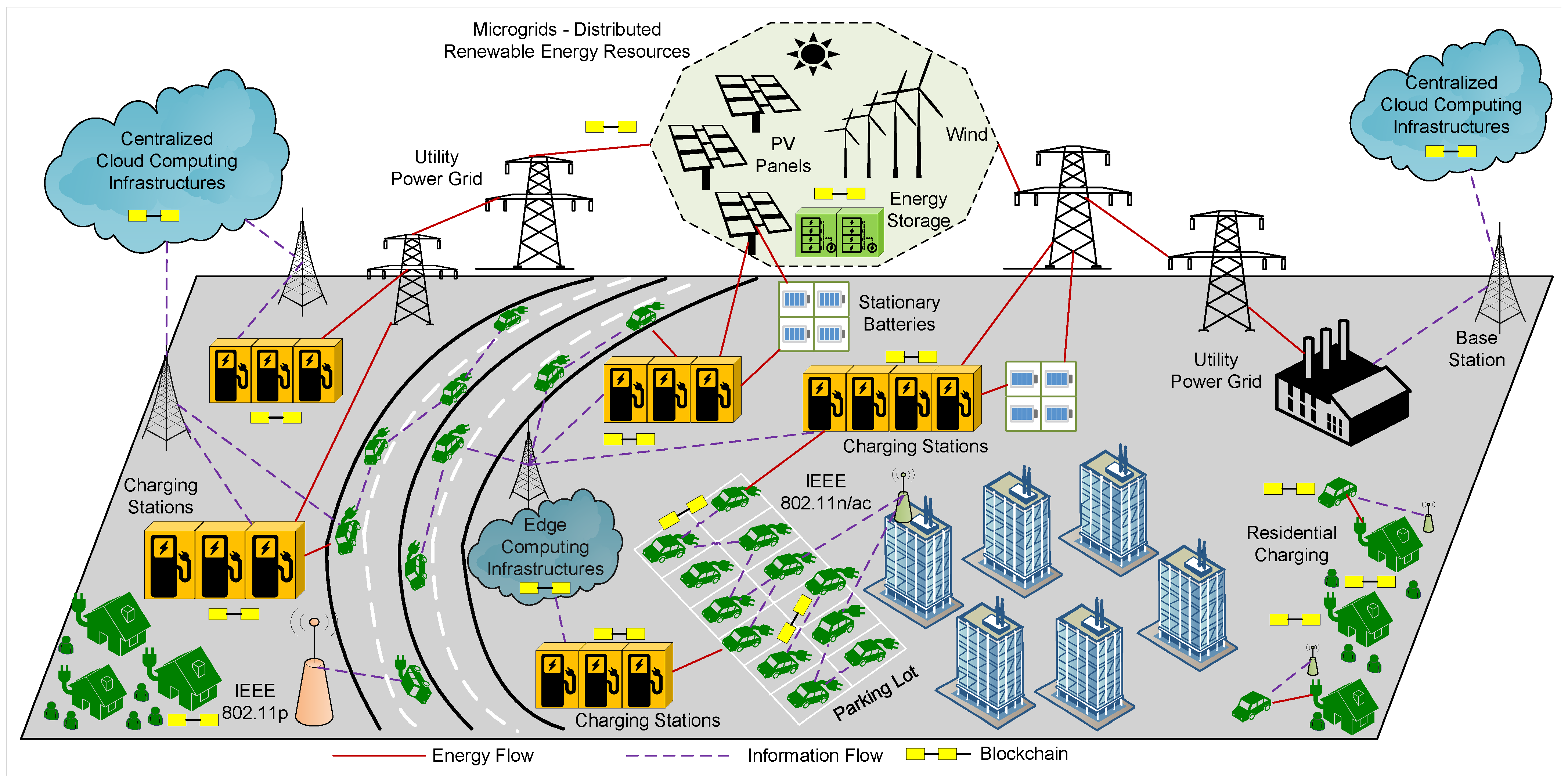
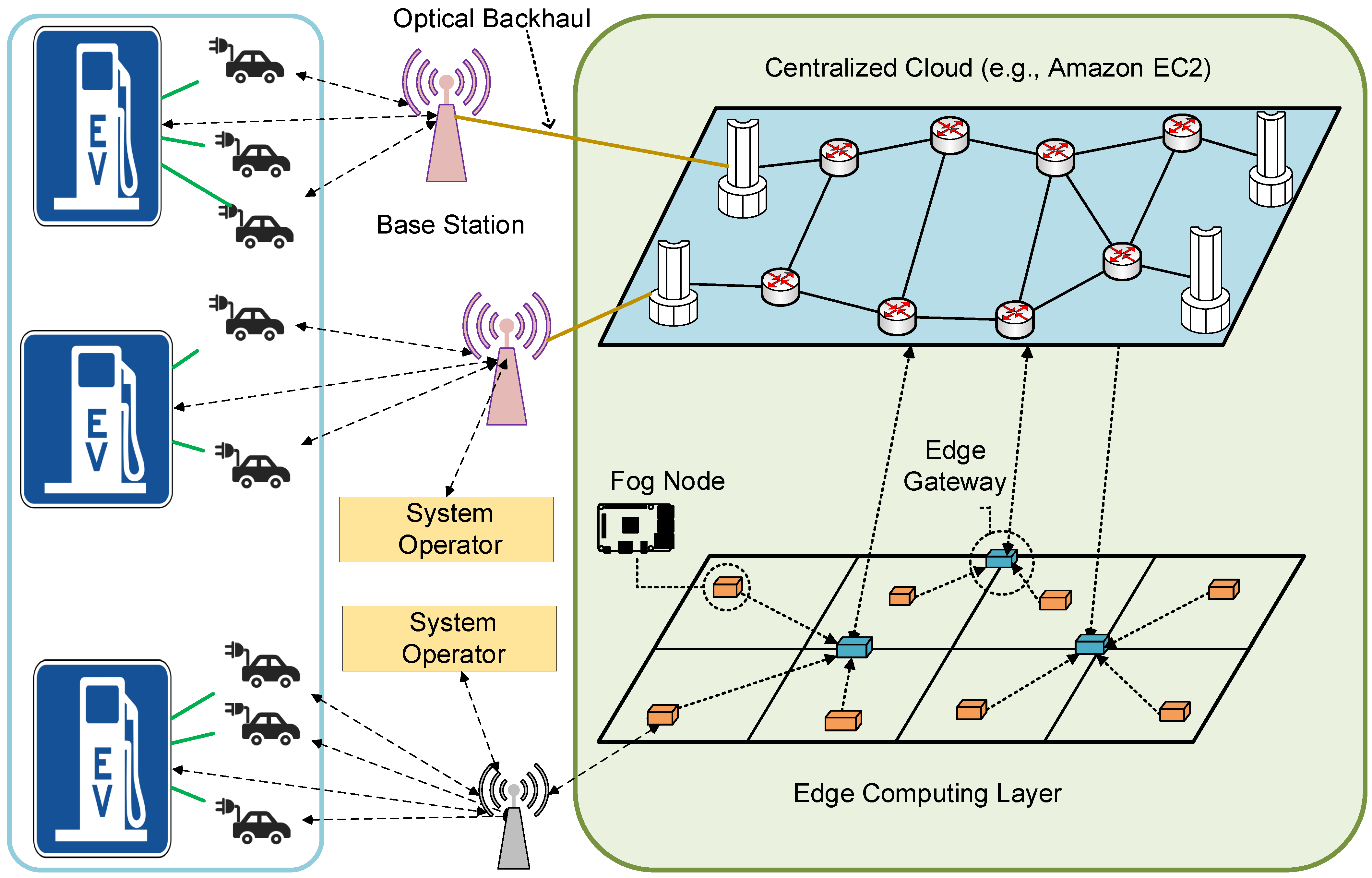
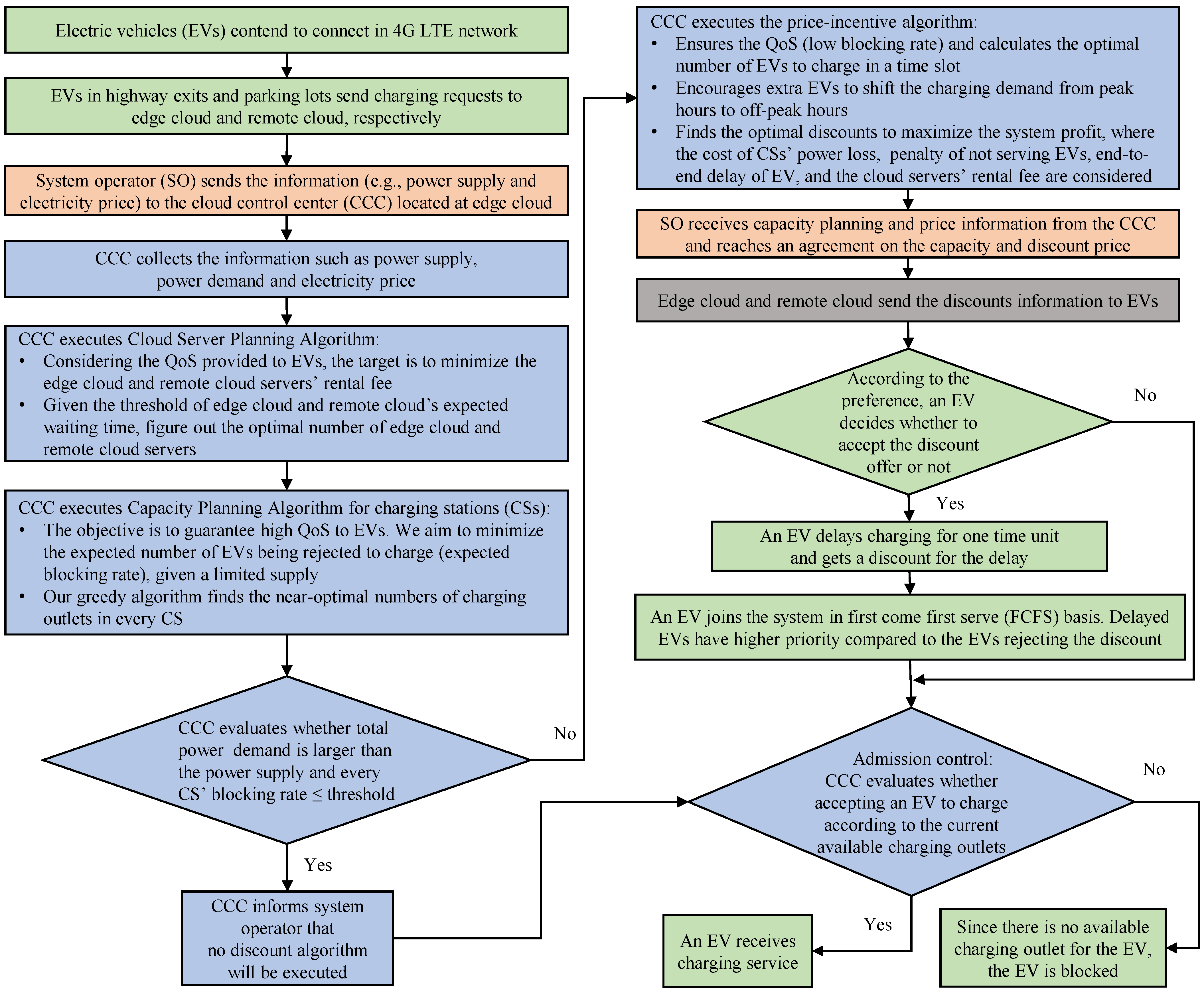
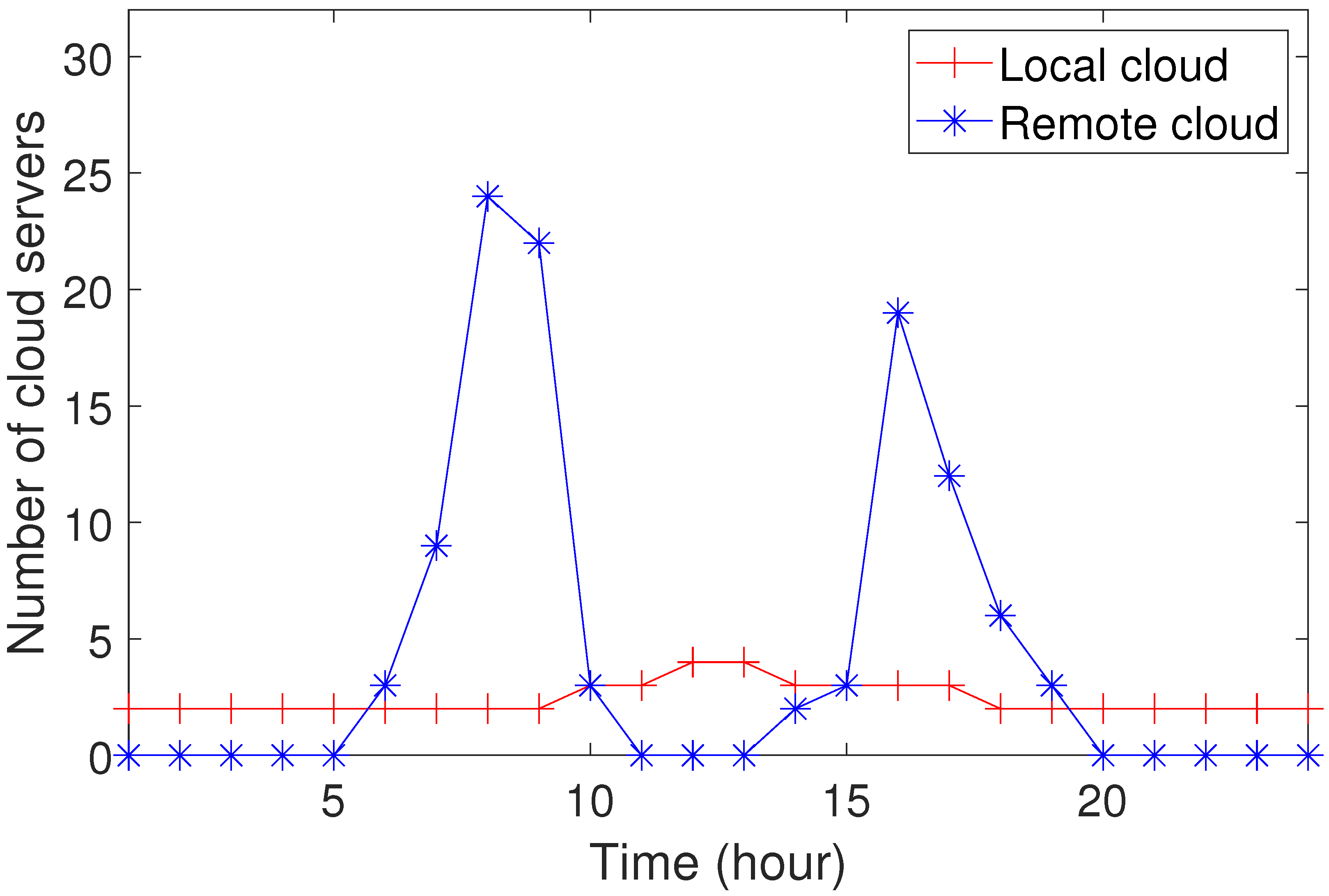

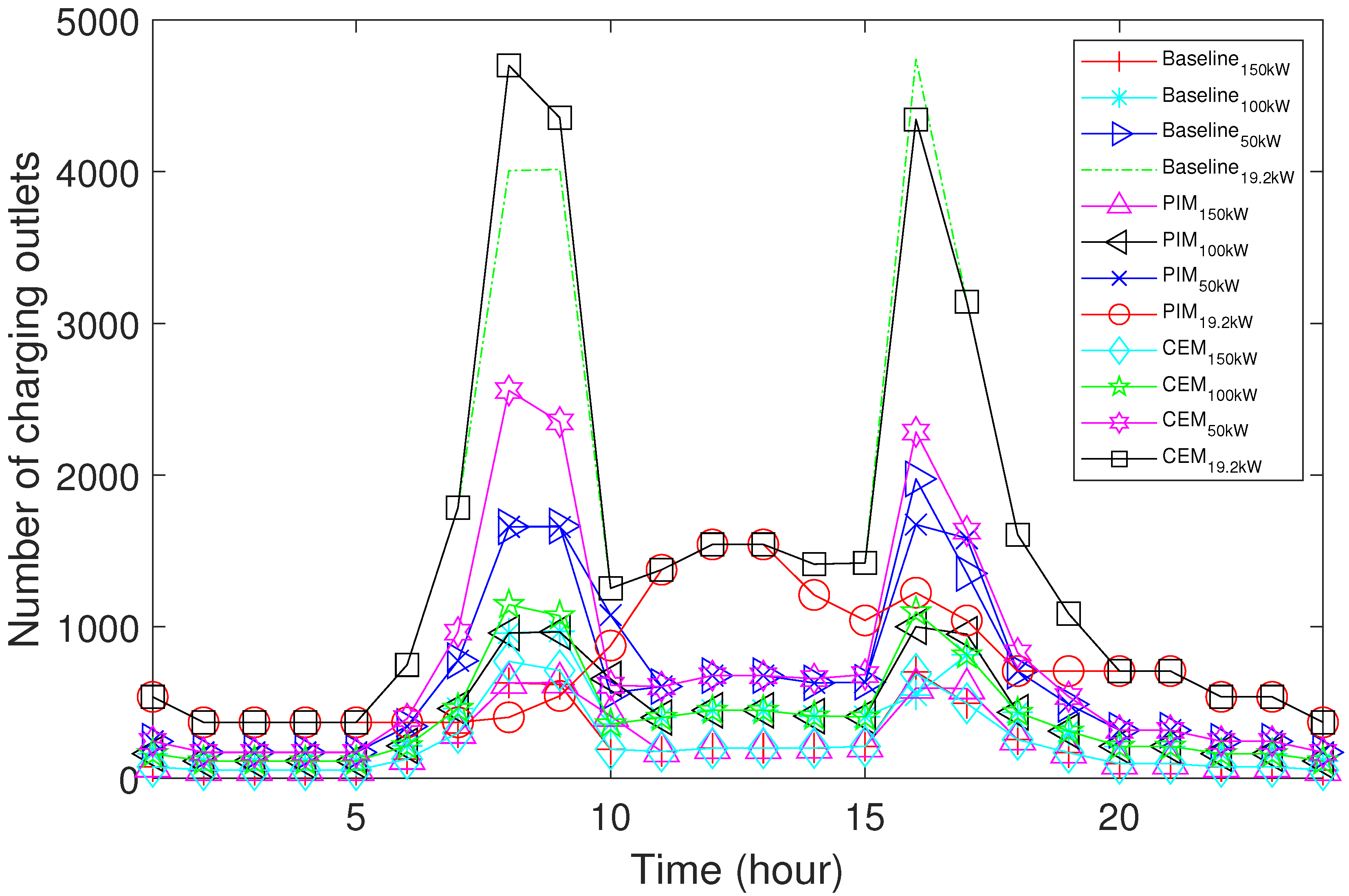
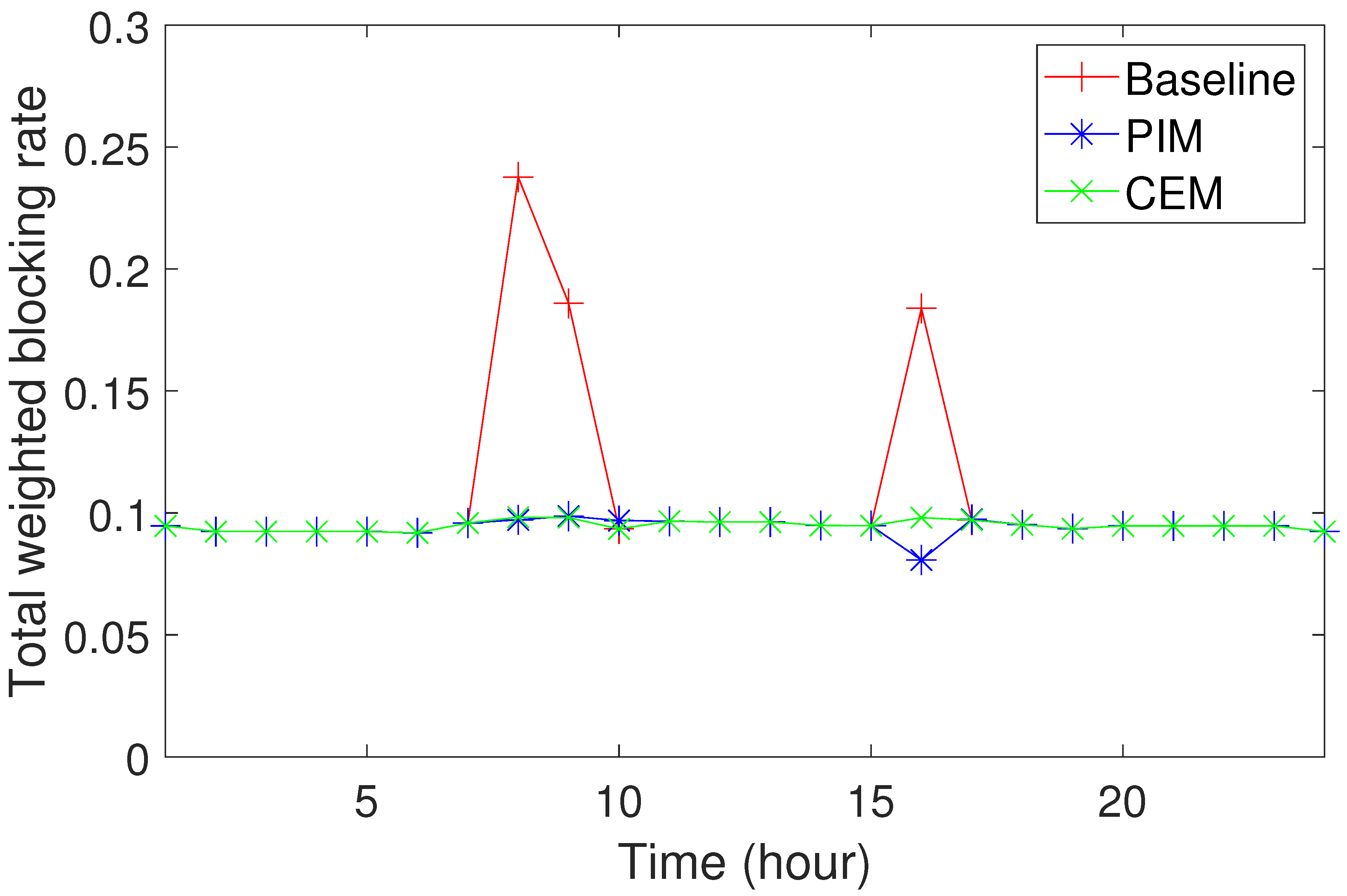
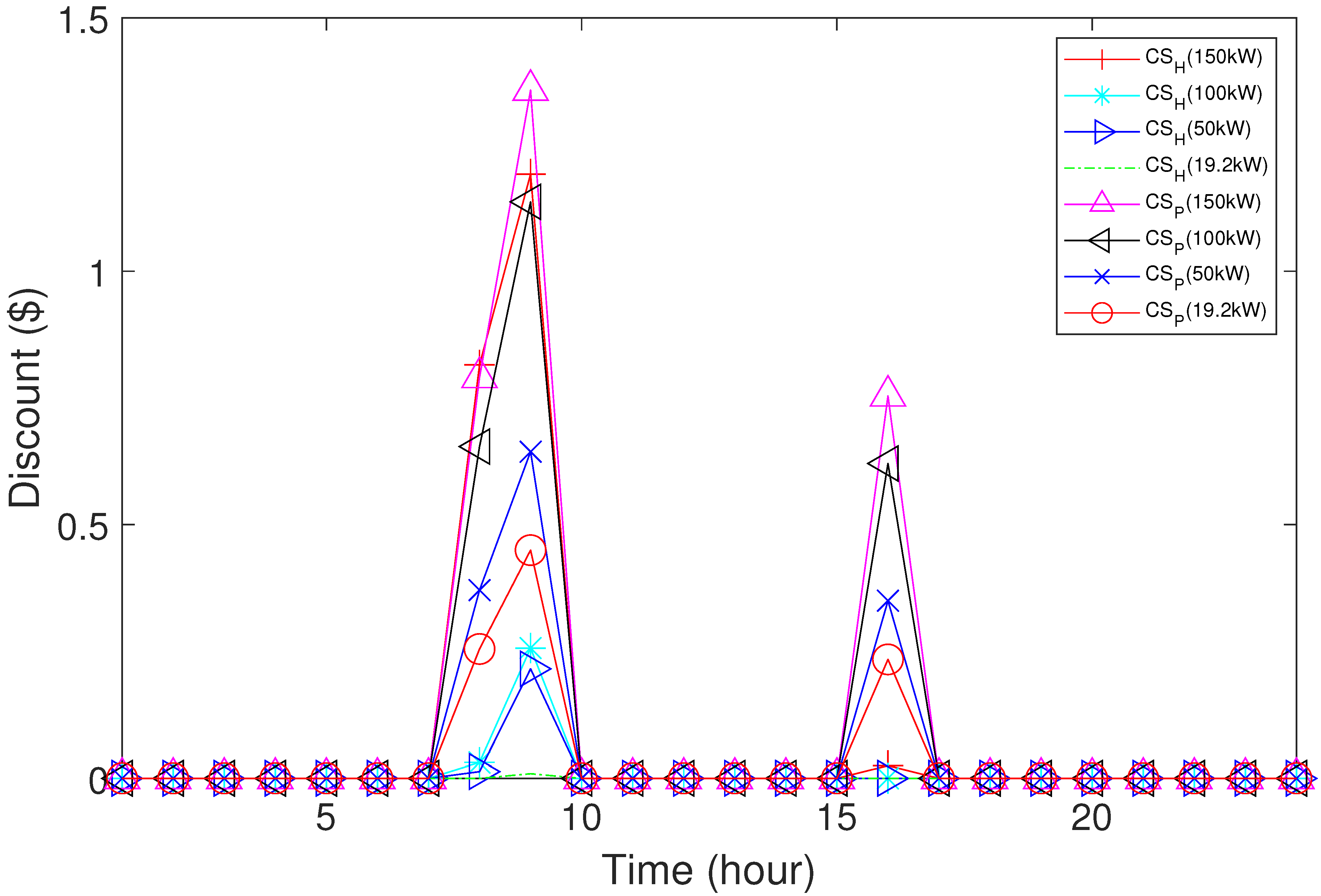
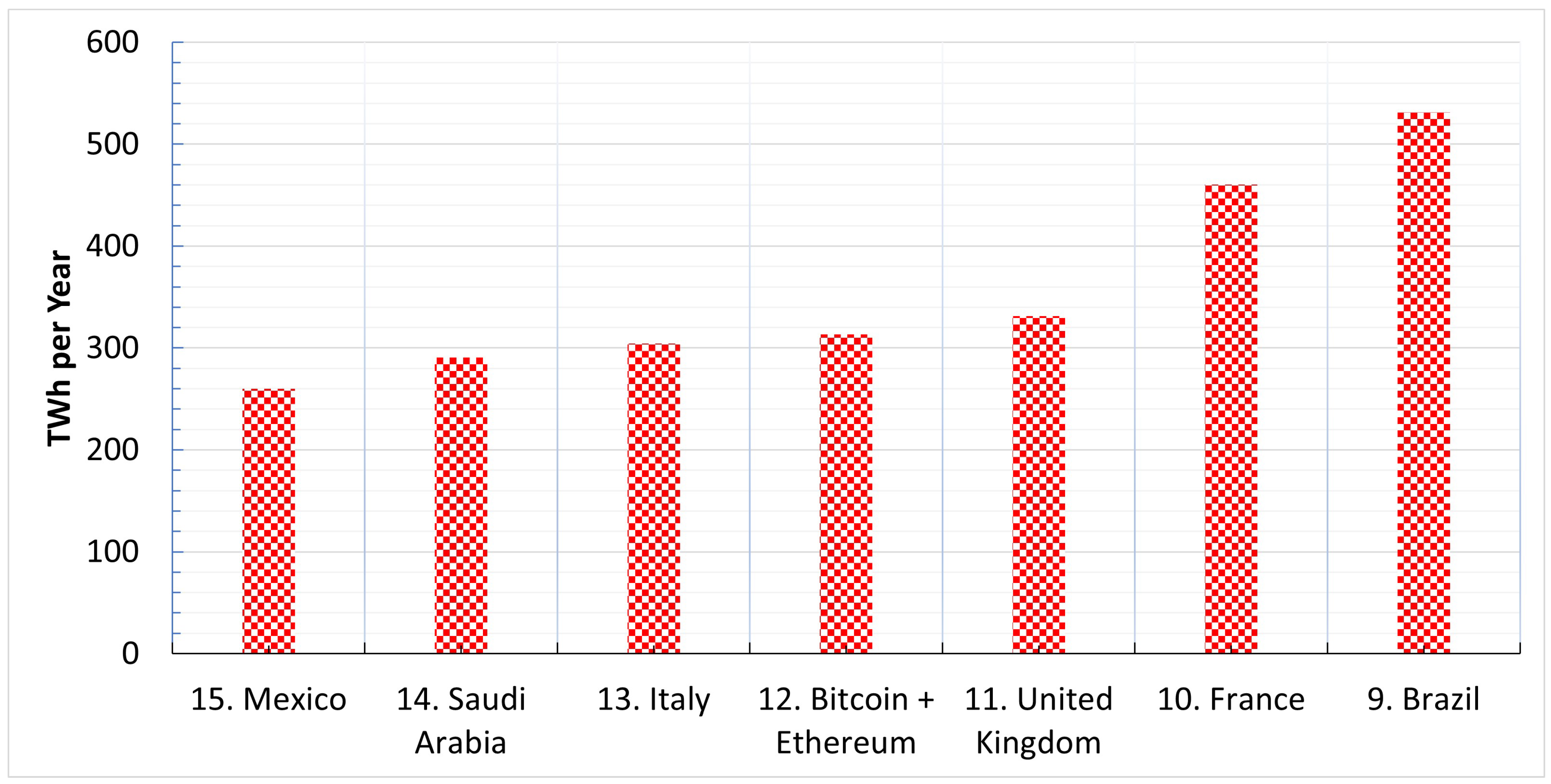

| Parameters | C-V2X (or LTE V2X) | DSRC |
|---|---|---|
| Channel coding | Turbo codes (for data channel) and tail-biting convolutional code (TBCC) (for control channel) | Convolution codes |
| Synchronization | Synchronous | Asynchronous |
| Transmission scheme | Single-carrier frequency division multiplexing (SC-FDM), which allows more transmit power than OFDM | Orthogonal frequency division multiplexing (OFDM) |
| Resource multiplexing across vehicles | Frequency-division multiplexing (FDM) and time-division multiplexing (TDM) | TDM |
| Resource selection | Semi-persistent scheduling or dynamic scheduling | Carrier sense multiple access with collision avoidance (CSMA-CA) |
| Spectrum band | 5.9 GHz | North America: MHz; Europe: MHz, MHz; Japan: MHz, MHz |
| Standard | 3GPP—Release 14 and roadmap towards 5G | IEEE 802.11p |
| Retransmission | Hybrid Automatic Repeat Request (HARQ) | No HARQ |
| Transmission range | Up to 225 m | Over 450 m via direct mode and more than that via cellular |
| Use cases | A wide range of use cases (e.g., road safety services, traffic flow optimization, enhanced positioning, control loss warning, emergency stop, curve speed warning, vehicle platooning, remote driving, extended sensor, and state map sharing a dynamic ride sharing, collective perception of the environment, high-definition content delivery) | Limited use cases (e.g., vehicular safety applications, V2V communications, toll collection) |
| Roadmap | Leverages and enhances existing LTE networks with roadmap toward 5G-based V2X | Not many new activities in IEEE 802.11 standards for next-generation DSRC technology. Cellular D2D may obsolete IEEE 802.11p, but hybrid and complementary solutions are possible. |
| Parameters | Value |
|---|---|
| Transmission bandwidth | 20 MHz |
| Transmission rate | 5 Mbps |
| Charging levels (kW) | 150, 100, 50, 19.2 |
| Electricity supply | 350 MW |
| Service rate of edge cloud servers | 2400 EVs/h |
| Service rate of remote cloud servers | 600 EVs/h |
| Battery size for 2020 Nissan Leaf EVs | 40 kWh |
| Battery size for Jaguar | 85 kWh |
| Charging levels for 2020 Nissan Leaf EVs | 50 kW, 19.2 kW |
| Charging levels for Jaguar | 150 KW, 100 kW |
| Number of charging stations at highway exits | 20 |
| Number of charging stations at parking lots | 20 |
| EV arrival rate at highway exits (hourly) | 4, 2, 3.2, 3, 2.5, 1, 2, 3.5, 2.8, 2.5, 3, 1.8, 2.8, 3.6, 2, 1.2, 2.7, 2.8, 2, 3, 5 (thousand) |
| EV arrival rate at parking lots (hourly) | 3.2, 2.5, 2.2, 5, 3.3, 2.5, 1.7, 1.6, 3, 2, 3, 2.8, 2.9, 3, 3, 2.8, 2.5, 1.9, 3, 1.8 |
| Number of charging stations at highway exits with 150, 100, 50, and 19.2 kW charging level, respectively | 4, 4, 6, 6 |
| Number of charging stations at parking lots with 150, 100, 50, and 19.2 kW charging level, respectively | 4, 4, 6, 6 |
Publisher’s Note: MDPI stays neutral with regard to jurisdictional claims in published maps and institutional affiliations. |
© 2022 by the authors. Licensee MDPI, Basel, Switzerland. This article is an open access article distributed under the terms and conditions of the Creative Commons Attribution (CC BY) license (https://creativecommons.org/licenses/by/4.0/).
Share and Cite
Rimal, B.P.; Kong, C.; Poudel, B.; Wang, Y.; Shahi, P. Smart Electric Vehicle Charging in the Era of Internet of Vehicles, Emerging Trends, and Open Issues. Energies 2022, 15, 1908. https://doi.org/10.3390/en15051908
Rimal BP, Kong C, Poudel B, Wang Y, Shahi P. Smart Electric Vehicle Charging in the Era of Internet of Vehicles, Emerging Trends, and Open Issues. Energies. 2022; 15(5):1908. https://doi.org/10.3390/en15051908
Chicago/Turabian StyleRimal, Bhaskar P., Cuiyu Kong, Bikrant Poudel, Yong Wang, and Pratima Shahi. 2022. "Smart Electric Vehicle Charging in the Era of Internet of Vehicles, Emerging Trends, and Open Issues" Energies 15, no. 5: 1908. https://doi.org/10.3390/en15051908
APA StyleRimal, B. P., Kong, C., Poudel, B., Wang, Y., & Shahi, P. (2022). Smart Electric Vehicle Charging in the Era of Internet of Vehicles, Emerging Trends, and Open Issues. Energies, 15(5), 1908. https://doi.org/10.3390/en15051908






